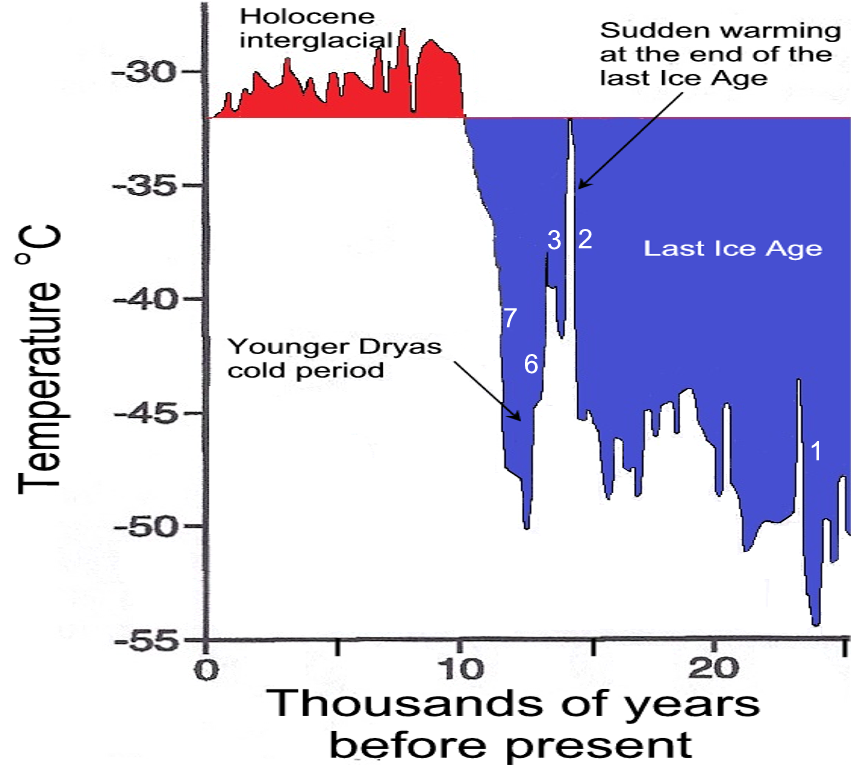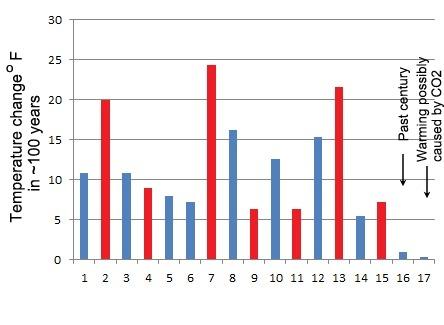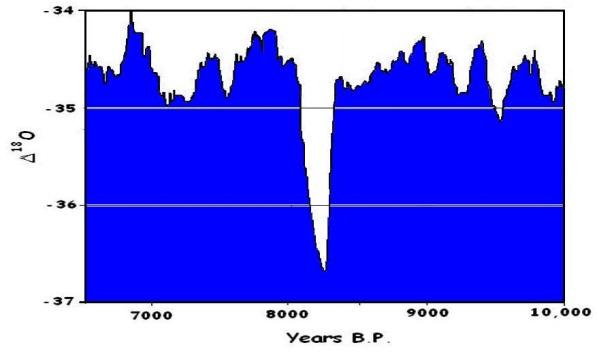The ratio of 18O to 16O depends on the temperature at the time snow crystals formed, which were later transformed into glacial ice. Ocean volume may also play a role in δ18O values, but δ18O serves as a good proxy for temperature. The oxygen isotopic composition of a sample is expressed as a departure of the 18O/16O ratio from an arbitrary standard
δ18O =
(18O/16O)sample ‒ (18O/16O) x 103
____________________________________
(18O/16O)standard
where δ18Ois the of ratio 18O/16O expressed in per mil (0/00) units.
The age of each sample is accurately known from annual dust layers in the ice core. The top of the core is 1987.
The δ18O data clearly show remarkable swings in climate over the past 100,000 years. In just the past 500 years, Greenland warming/cooling temperatures fluctuated back and forth about 40 times, with changes every 25-30 years (27 years on the average). None of these changes could have been caused by changes in atmospheric CO2 because they predate the large CO2 emissions that began about 1945. Nor can the warming of 1915 to 1945 be related to CO2, because it pre-dates the soaring emissions after 1945. Thirty years of global cooling (1945 to 1977) occurred during the big post-1945 increase in CO2.
But what about the magnitude and rates of climates change? How do past temperature oscillations compare with recent global warming (1977-1998) or with warming periods over the past millennia. The answer to the question of magnitude and rates of climate change can be found in the δ18O and borehole temperature data.
Temperature changes in the GISP2 core over the past 25,000 years are shown in Figure 1 (from Cuffy and Clow, 1997). The temperature curve in Figure 1 is a portion of their original curve. I've added color to make it easier to read. The horizontal axis is time and the vertical axis is temperature based on the ice core δ18O and borehole temperature data. Details are discussed in their paper. Places where the curve becomes nearly vertical signify times of very rapid temperature change. Keep in mind that these are temperatures in Greenland, not global temperatures. However, correlation of the ice core temperatures with world-wide glacial fluctuations and correlation of modern Greenland temperatures with global temperatures confirms that the ice core record does indeed follow global temperature trends and is an excellent proxy for global changes. For example, the portions of the curve from about 25,000 to 15,000 represent the last Ice Age (the Pleistocene) when huge ice sheets thousands of feet thick covered North America, northern Europe, and northern Russia and alpine glaciers readvanced far downvalley.
So let's see just how the magnitude and rates of change of modern global warming/cooling compare to warming/cooling events over the past 25,000 years. We can compare the warming and cooling in the past century to approximate 100 year periods in the past 25,000 years. The scale of the curve doesn't allow enough accuracy to pick out exactly 100 year episodes directly from the curve, but that can be done from the annual dust layers in ice core data. Thus, not all of the periods noted here are exactly 100 years. Some are slightly more, some are slightly less, but they are close enough to allow comparison of magnitude and rates with the past century.
Temperature changes recorded in the GISP2 ice core from the Greenland Ice Sheet (Figure 1) (Cuffy and Clow, 1997) show that the global warming experienced during the past century pales into insignificance when compared to the magnitude of profound climate reversals over the past 25,000 years. In addition, small temperature changes of up to a degree or so, similar to those observed in the 20th century record, occur persistently throughout the ancient climate record.


Some of the more remarkable sudden climatic warming periods are shown listed below (refer also to Figure 1).
1. About 24,000 years ago, while the world was still in the grip of the last Ice Age and huge continental glaciers covered large areas, a sudden warming of about 20°F occurred. Shortly thereafter, temperatures dropped abruptly about 11°F. Temperatures then remained cold for several thousand years but oscillated between about 5°F warmer and cooler.
2. About 15,000 years ago, a sudden, intense, climatic warming of about 21°F (~12° C;) caused dramatic melting of the large ice sheets that covered Canada and the northern U.S., all of Scandinavia, and much of northern Europe and Russia.
3. A few centuries later, temperatures again plummeted about 20° F (~11°C) and glaciers readvanced.
4. About 14,000 years ago, global temperatures once again rose rapidly, about 8° F (~4.5°C), and glaciers receded.
4. About 13,400 years ago, global temperatures plunged again, about 14° F (~8°C) and glaciers readvanced.
5. About 13,200 years ago, global temperatures increased rapidly, 9° F (~5°C), and glaciers receded.
6. 12,700 yrs ago global temperatures plunged sharply, 14° F (~8°C) and a 1300 year cold period, the Younger Dryas, began.
7. After 1300 years of cold climate, global temperatures rose sharply, about 21° F (~12° C), 11,500 years ago, marking the end of the Younger Dryas cold period and the end of the Pleistocene Ice Age.
Early Holocene climate changes
8,200 years ago, the post-Ice Age interglacial warm period was interrupted by a sudden global cooling that lasted for a few centuries (Fig. 3). During this time, alpine glaciers advanced and built moraines. The warming that followed the cool period was also abrupt. Neither the abrupt climatic cooling nor the warming that followed was preceded by atmospheric CO2 changes.

750 B.C. to 200 B.C. cool period
Prior to the founding of the Roman Empire, Egyptians records show a cool climatic period from about 750 to 450 B.C. and the Romans wrote that the Tiber River froze and snow remained on the ground for long periods (Singer and Avery, 2007).
The Roman warm period (200 B.C. to 600 A.D.)
After 100 B.C., Romans wrote of grapes and olives growing farther north in Italy than had been previously possible and of little snow or ice (Singer and Avery, 2007).
The Dark Ages cool period (440 A.D. to 900 A.D.)
The Dark Ages were characterized by marked cooling. A particularly puzzling event apparently occurred in 540 A.D. when tree rings suggest greatly retarded growth, the sun appeared dimmed for more than a year, temperatures dropped in Ireland, Great Britain, Siberia, North and South America, fruit didn't ripen, and snow fell in the summer in southern Europe (Baillie in Singer and Avery, 2007). In 800 A.D., the Black Sea froze and in 829 A.D. the Nile River froze (Oliver, 1973).
The Medieval Warm Period (900 A.D. to 1300 A.D.)
The Medieval Warm Period (MWP) was a time of warm climate from about 900 - 1300 AD when global temperatures were apparently somewhat warmer than at present. Its effects were particularly evident in Europe where grain crops flourished, alpine tree lines rose, many new cities arose, and the population more than doubled. The Vikings took advantage of the climatic amelioration to colonize Greenland, and wine grapes were grown as far north as England where growing grapes is now not feasible and about 500 km north of present vineyards in France and Germany. Grapes are presently grown in Germany up to elevations of about 560 meters, but from about 1100 to 1300 A.D., vineyards extended up to 780 meters, implying temperatures warmer by about 1.0 to 1.4° C (Oliver, 1973, Tkachuck, 1983). Wheat and oats were grown around Trondheim, Norway, suggesting climates about one degree C warmer than present (Fagan, 2007).
The Vikings colonized southern Greenland in 985 AD during the Medieval Warm Period when milder climates allowed favorable open-ocean conditions for navigation and fishing. This was "close to the maximum Medieval warming recorded in the GISP2 ice core at 975 AD (Stuiver et al., 1995).
Elsewhere in the world, prolonged droughts affected the southwestern United States and Alaska warmed. Sediments in Lake Nakatsuna in central Japan record warmer temperatures. Sea surface temperatures in the Sargasso Sea were approximately 1°C warmer than today and the climate in equatorial east Africa was drier from 1000 - 1270 AD. An ice core from the eastern Antarctic Peninsula shows warmer temperatures during this period.
The Little Ice Age (1300 A.D. to the 20th century)
At the end of the Medieval Warm Period, ~1230 AD, temperatures dropped ~4°C (~7° F) in ~20 years and the cold period that followed is known as the Little Ice Age. The colder climate that ensued for several centuries was devastating (see e.g., Grove, 1988, 2004; Singer and Avery, 2007; Fagan, 2000). Temperatures of the cold winters and cool, rainy summers were too low for growing of cereal crops, resulting in widespread famine and disease. When temperatures declined during the 30 - year cool period from the late 1940's to 1977, some climatologists and meteorologists predicted a return to a new Little Ice Age.
Glaciers expanded worldwide (see e.g., Grove, 1988, 2004; Singer and Avery, 2007). Glaciers in Greenland advanced and pack-ice extended southward in the North Atlantic in the 13th century. The population of Europe had become dependent on cereal grains as a food supply during the Medieval Warm Period and when the colder climate, early snows, violent storms, and recurrent flooding swept Europe, massive crop failures occurred. Three years of torrential rains that began in 1315 led to the Great Famine of 1315-1317. The Thames River in London froze over, the growing season was significantly shortened, crops failed repeatedly, and wine production dropped sharply (Fagan, 2000; Singer and Avery, 2007).
Winters during the Little Ice Age were bitterly cold in many parts of the world. Advance of glaciers in the Swiss Alps in the mid - 17th century gradually encroached on farms and buried entire villages. The Thames River and canals and rivers of the Netherlandsfrequently froze over during the winter. New York Harbor froze in the winter of 1780 and people could walk from Manhattan to Staten Island. Sea ice surrounding Iceland extended for miles in every direction, closing many harbors. The population of Iceland decreased by half and the Viking colonies in Greenland died out in the 1400s because they could no longer grow enough food there. In parts of China, warm weather crops that had been grown for centuries were abandoned. In North America, early European settlers experienced exceptionally severe winters.
Significance of previous global climate changes
If CO2 is indeed the cause of global warming, then global temperatures should mirror the rise in CO2. For the past 1000 years, atmospheric CO2 levels remained fairly constant at about 280 ppm (parts per million). Atmospheric CO2 concentrations began to rise during the industrial revolution early in the 20th century but did not exceed about 300 ppm. The climatic warming that occurred between about 1915 and 1945 was not accompanied by significant rise in CO2. In 1945, CO2 emission began to rise sharply and by 1980 atmospheric CO2. had risen to just under 340 ppm. During this time, however, global temperatures fell about 0.9°F (0.5° C) in the Northern Hemisphere and about 0.4°F (0.2° C) globally. Global temperatures suddenly reversed during the Great Climate Shift of 1977 when the Pacific Ocean switched from its cool mode to its warm mode with no change in the rate of CO2 increase. The 1977 - 1998 warm cycle ended in 1999 and a new cool cycle began. If CO2 is the cause of global warming, why did temperatures rise for 30 years (1915-1945) with no significant increase in CO2? Why did temperatures fall for 30 years (1945-1977) while CO2 was sharply accelerating? Logic dictates that this anomalous cooling cycle during accelerating CO2 levels must mean either (1) rising CO2 is not the cause of global warming or (2) some process other than rising CO2 is capable of strongly overriding its effect on global atmospheric warming.
Temperature patterns since the Little Ice Age (~1300 to 1860 A.D.) show a very similar pattern; 25 - 30 year - long periods of alternating warm and cool temperatures during overall warming from the Little Ice Age low. These temperature fluctuations took place well before any significant effect of anthropogenic atmospheric CO2.
Conclusions
Temperature changes recorded in the GISP2 ice core from the Greenland Ice Sheet show that the magnitude of global warming experienced during the past century is insignificant compared to the magnitude of the profound natural climate reversals over the past 25,000 years, which preceded any significant rise of atmospheric CO2. If so many much more intense periods of warming occurred naturally in the past without increase in CO2, why should the mere coincidence of a small period of low magnitude warming this century be blamed on CO2?



Comment: Man-made global warming is just a myth, which is promoted by the global elite through their scientists to cover for the fact that it is events like the recent meteor explosion over Chelyabinsk that have caused the rapid onset of ice-ages through the ages. Read the books: The Apocalypse: Comets, Asteroids and Cyclical Catastrophes and Comets and the Horns of Moses by Laura Knight-Jadczyk, for a better understanding of these events that plaque our Earth periodically, and have been increasing in occurrence the past few years, causing the climate changes that we are currently experiencing.